Chef knives have gained an almost mythical aura, and rightly so. A quality knife is a chef’s workhorse, your best friend in the kitchen, and let’s face it – one heck of a sexy item.
This article will help you to indulge your kitchen blade fetishism guilt-free, and to hone your chef knife purchasing skills (pun intended!) to a fine point. Once you’ve read this handy purchasing guide, check out our list of best chef knives.
Read now: The 5 best chef knives – 2023 Reviews
How to choose the best chef knife for you?
The modern chef’s knife or cook’s knife is a general-utility kitchen knife used for all manner of food preparation – from cutting and filleting meat, poultry, or fish, to chopping and dicing vegetables, fruits, and herbs, to slicing bread and cheese and beyond. Simply put, it is the most versatile knife at a cook’s disposal.
There are a few uses for which a chef knife is not suited: rough jobs such as cutting through bone or frozen products (which requires a cleaver) and delicate jobs such as peeling or julienning (which requires a paring knife, a peeler, etc.). Chef knives come in many styles and designs, and the “best” knife is the best knife for you, depending on personal preference and what you intend to use it for. Following is a rundown of the main things to consider.
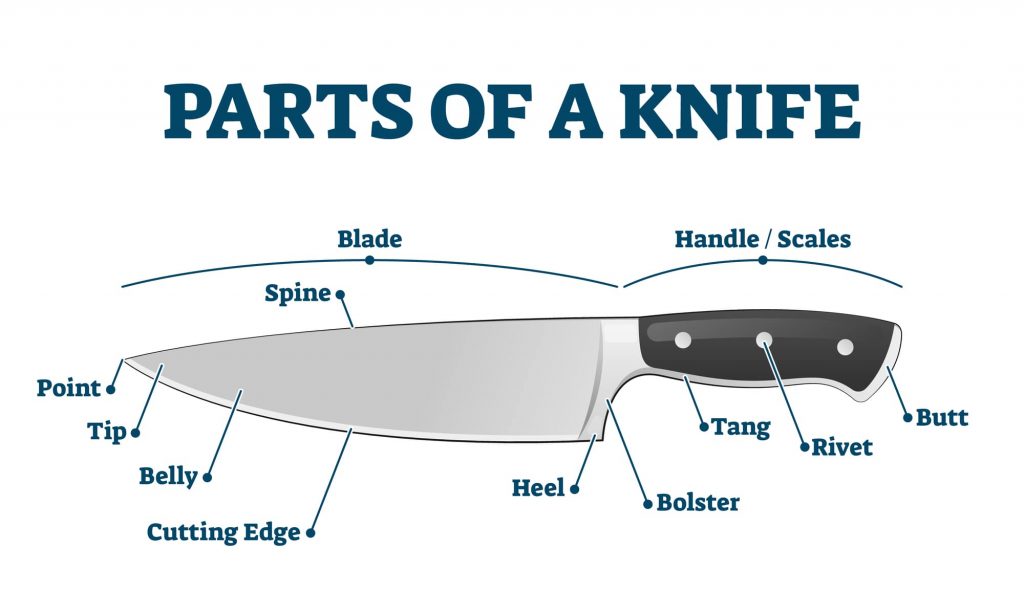
Price – How Much Does A Chef Knife Cost?
Chef knives run the gamut price-wise, with top-end knives commanding prices north of $300 USD, and even into the thousands of dollars. Most people, however, search for quality knives in the neighborhood of 50 up to 300 dollars.
Read now: Best Chef’s Knives Under $200
Are Chef Knives Worth it?
Absolutely. Quality knives are made to last, and a well-maintained chef knife can serve you for life. It might sound poetic, but after spending hundreds of kitchen hours together with one’s chef knife, a bond forms. Trust us, it’ll happen to you too.
Dimensions – The Length & Weight of a chef knife
The first things to consider in buying a chef knife are its length and weight.
The Length of a chef Knife
The length of a chef knife includes the blade but not the handle. For domestic use, the typical chef knife is 6-8” (15-20cm) long. Professional chefs often use larger 10-12” (25-30cm) knives, but these are heavier and harder to use over long periods – as well as more dangerous for the untrained user.
What Is The Best Length for A Chef’s Knife?
If you’re a home chef, then a 6-8” (15-20cm) blade will serve you perfectly for 99% of your knife duties. It should neither feel like a sword nor a dagger but like a happy, comfortable medium.

The Weight of a chef Knife
Chef knives can be heavy or light, depending on size, shape, and material. Heavier knives tend to weigh 7-13 oz. (200-370g), while lighter knives generally fall in the 7-9 oz. (200-260g) range.
What Is a Good Weight for A Chef’s Knife?
There is a view that heavier knives cut better by applying bigger force, while a competing view holds that lighter knives glide easier through the material. Many people prefer heavier knives, which feel more solid, but it is down to personal preference. It’s important to remember that you’ll be holding up the knife for long periods, so choose a weight that will feel solid but won’t tire your forearm.
The Chef Knife’s Blade
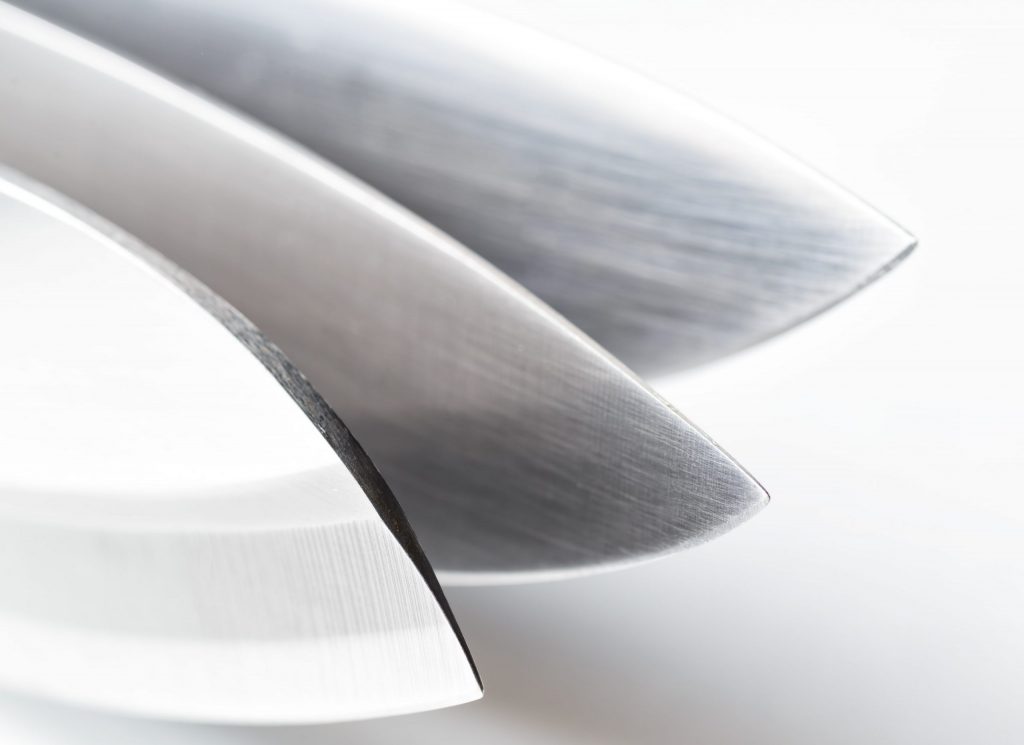
The blade of a chef knife consists of several parts, which we’ll touch on in later sections:
- The edge – the sharp part that cuts
- The spine – the dull part on top, to which pressure is sometimes applied during, e.g., chopping
- The heel and point – the closest and farthest tips of the blade, respectively
- The tang – the part of the blade that connects to the knife’s handle
- The bolster (found in forged knives) – the fat part at the base of the blade, used both for balancing the knife’s weight and for gripping the knife (more on this later)
What is the difference between Forged and Stamped Blades?
Forged knives are, as the name implies, created by forging metal (often steel) into shape, while stamped knives are cut with a die out of sheet metal.
Forged knives tend to be tougher, longer-lasting, and easier to sharpen since they don’t bend easily, while stamped knives are generally easier on the wallet and come in a wide variety.
If you’re on a budget, a stamped knife can be perfectly serviceable, and if you’re looking for a good long-term investment, go with forged.
Blade Material – What material should the chef’s knife blade be made of?
Chef blades are made from a variety of materials, each with its pros and cons relative to the others. The most commonly used materials include:
- Carbon steel – an alloy of iron with a small amount of carbon. These blades are easier to sharpen than stainless steel ones, and usually hold an edge longer (which is why some professional chefs swear by them), but are more brittle and vulnerable to rust and stains – thus requiring higher maintenance. Carbon steel knives also develop a patina, which some prefer as a mark of “mileage” on the knife.
- Stainless steel – an alloy of iron, chromium/nickel/molybdenum, and just a small amount of carbon. These blades are resistant to corrosion, but don’t take an edge as well as high-carbon steel – although specific, higher-grade stainless steel may match or outperform carbon steel blades.
- Laminated steel – a layered or combined blade that incorporates several materials to take advantage of their respective strengths. A laminated blade, for example, might use more ductile and durable steel as the core material and harder, sharper steel for the edge. There’s more than one combination, so make sure to read the fine print on these.
- Ceramic – ceramic blades are generally made of zirconia (zirconium dioxide) rather than steel. Ceramic chef knives hold an edge much longer than steel – sometimes as much as 10 times longer – but require specialized sharpening and are more vulnerable to chipping. In other words, it’s a tradeoff: the edge will last longer, but once it degrades, you’ll have to get the knife serviced or replace it.
- Damascus steel – an ancient (and now modernized) forged steel made by layering several types of steel, resulting in a tough, shatter-resistant blade with a distinctive wavelike visual pattern. These aesthetically-pleasing blades can be sharpened to a fine, resilient edge. On the downside, they do tend to cost more. Review the best Damascus chef knives.
- Titanium – Titanium is a type of metal. Naturally resistant to corrosion and abrasion, titanium blades are harder and more lightweight than steel – but also more brittle, don’t hold an edge quite as well, and require frequent sharpening. Consider them a stylish, if expensive, alternative to steel.
Blade Flexibility – Should a Chef’s Knife have a flexible blade?
The flexibility of your chef knife’s blade, which depends on its dimensions and material, affects the types of tasks it is best suited for. Chef knives are graded as flexible, semi-flexible (or semi-stiff), and stiff.
As a rule, the stiffer the blade, the heavier its duties. If you’re deboning, trimming, or filleting fish or chicken, for example, you want a flexible or at most a semi-stiff blade; while a semi-stiff or stiff blade lends itself more easily to precise work such as cutting beef and pork.
Of course, there’s a limit, and as mentioned, cutting through bone, frozen products, etc. is best left to a cleaver rather than a chef knife.
Blade Width/Thickness – How thick should a chef’s knife blade be?
Stated in mm/in., the thickness of a chef knife’s blade is measured at the spine/heel and tapers down as you get towards the edge/tip. Thinner blades are generally thought to cut easier, while thicker blades are naturally more stable. Thus, you should follow similar rules to those of the flexibility of the blades (thicker for heavy-duty work; thinner for finer tasks), with 0.2 In. (0.508cm) and above considered thick, 0.01-0.08in. (0.0254-0.2cm) considered thin, and 0.1-0.15in. (0.254- 0.381cm) considered a happy medium.
Tang
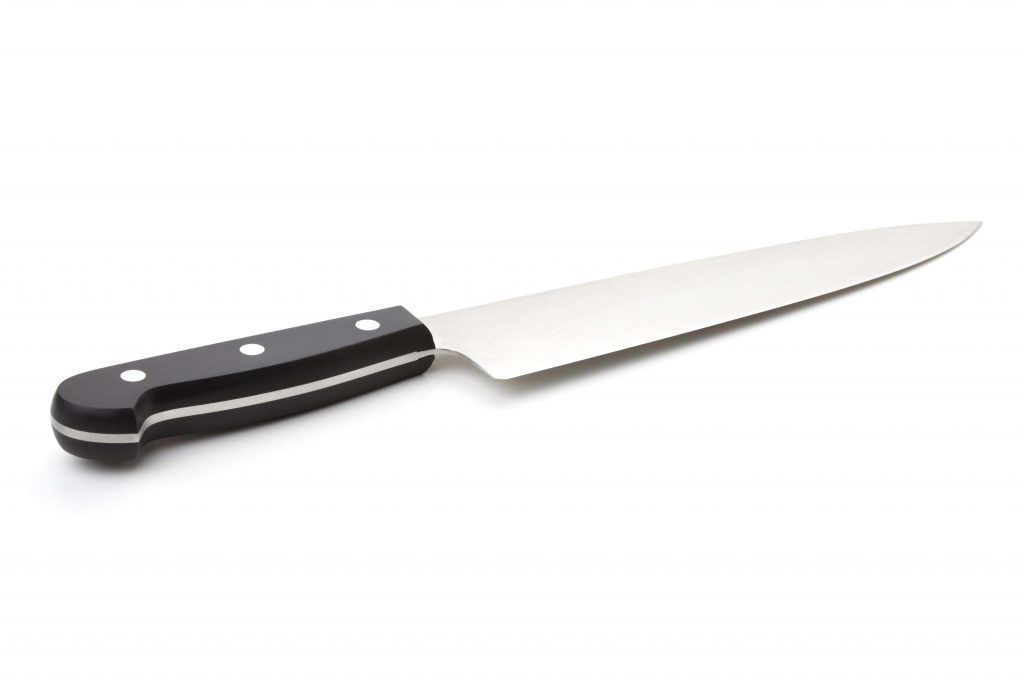
The tang is the part of the blade that connects to the handle of the chef knife. A full tang runs the entire length and width of the handle, with both parts of the handle (called “scales”) on either side; while a partial tang runs only partway into the handle, and can thus be buried within it.
Partial tangs come in many shapes – from a half-tang that runs flat across the full width but only half the length of the handle to a thin rattail tang that runs the full length but only part of the width of the handle, and more. A full tang allows for better control, leverage, and balance, so it is generally the preferred option – but a chef knife with a partial tang can be excellently designed in other aspects. So just keep the tang in mind as one of the finer points (yes, that was a pun) in buying a knife.
HRC
HRC stands for “Hardness Rockwell C”, a type of test to determine the hardness of materials against deformation. For our purposes, consider this a measure of the blade’s hardness.
Generally speaking, anything below 52 HRC is too soft; inexpensive knives rate at 52-54 HRC; experienced chefs tend to go for HRC 55 and above; and premium blades rate at HRC 59-64. Anything beyond that would be too brittle.
Edge Profile – What edge should a chef’s knife have?
The profile is the cross-section of the chef knife’s blade at the edge. Since this is the working part of the knife, the profile heavily affects the blade’s action and durability. Following are a few common edge profiles:
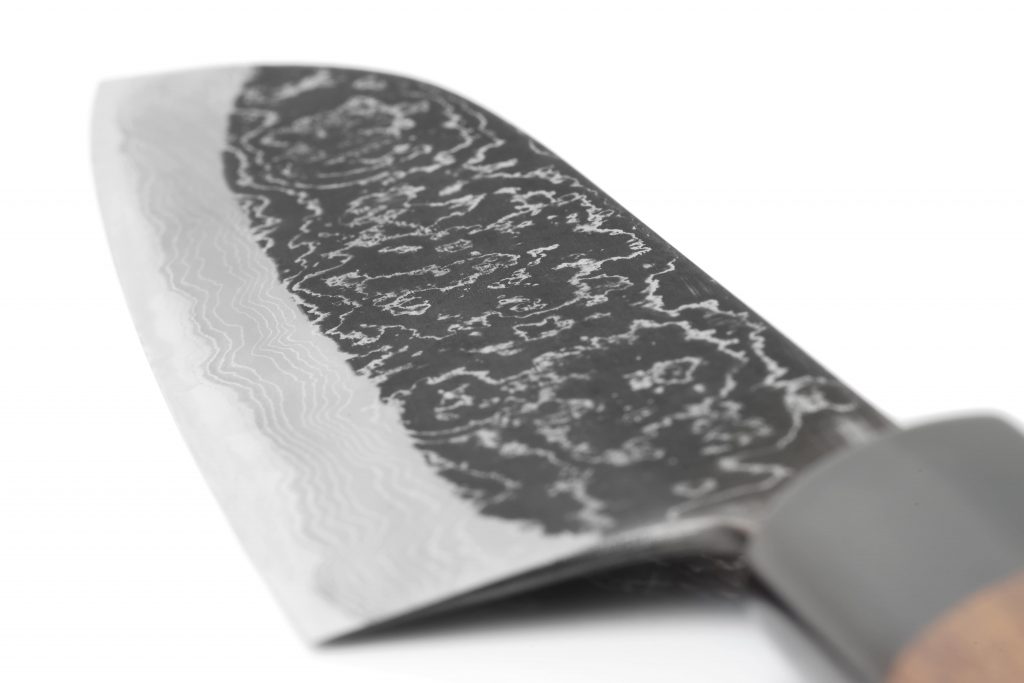
V-Edge
The classic, multipurpose edge: two straight sides coming to a single point. This tends to be the easiest edge to create when sharpening your own knife and lasts longer than more complex types.
Double Bevel
A V-edge that ends in its own, flatter V-edge. You’ll need to look closely to see it. The purpose of this design is to fortify the edge against rolling, cracking, and warping, thus maintaining longer durability and sharpness.- Hollow Edge or Concave Edge
An edge with scooped sides, leading to a very fine point. This makes for a sharper but more fragile blade that requires constant maintenance. More common in hunting knives, etc.
Convex Edge
An edge that curves to a point on both sides. Stronger than a V-edge but still sharp enough for most uses. Note that as you sharpen a convex blade, over time it will take on a V-shape.Chisel Edge or Single Bevel
An asymmetrical edge that is straight on one side but angled or beveled on the other. Single-bevel knives can be honed to extreme sharpness, allowing for intricate work such as filleting sushi, slicing very thinly, and making long, unbroken cuts.
Serrated Edge
A knife that is lined with small teeth along the blade – normally on one side only. Common in steak knives, bread knives, etc., and useful for safely sawing through soft or slippery foods. Tomatoes are a good example.
Some chef knives feature partial or very fine serration, but since serration doesn’t lend itself to a chopping motion, most chef knives are plain-edged, meaning no serration.
Indentations – Why do chef’s knives have indentations?
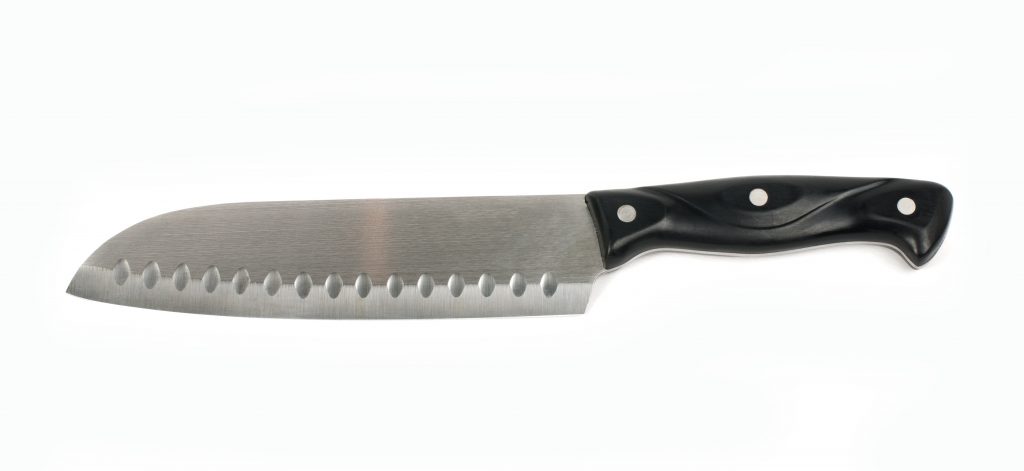
Indentations along the blade of a chef’s knife are designed to prevent food from “sucking” or adhering to the blade as you slice through. Think of tomatoes or cheese, for example. There are various types of indentations. For example, Granton-type blades have small dimples scalloped along the blade, creating little air pockets to prevent adhesion; while the Japanese Urasuki feature on chisel-edged blades means that the seemingly flat side of the blade is very slightly concave.
The Chef Knife’s Handle
The handle of a chef knife consists of several parts, including:
- The bolster – the thick metal part at the base of the blade. Actually a part of the blade, the bolster is used both to prevent your hand from slipping forward and for gripping and directing the knife. In one common grip, you place your thumb and forefinger over the bolster, while wrapping your remaining three fingers around the handle and exerting downward pressure with your palm.
- The main part – either the two scales on either side of a full tang (see above); or the entire material surrounding a partial tang.
- The rivets that clamp the handle to the tang.
- The butt – the rearmost part of the handle, is often made wider in order to prevent slippage and allow for a better grip.
As you may have guessed, the handle of your chef knife affects everything, from the comfort of use to the amount of control and precision you can apply. Remember: a handle that fits your hand will provide for better action and safety.
Here are some points to consider:
- Length and width – Make sure to pick a knife that fits your hand. Too big and it will be unwieldy; too small and it’ll flop around; both will tire you out.
- Design – Chef knife handles come in numerous shapes, some of which sit better in the hand, depending on your individual hand and the type of grip you use. There are also ergonomic handle designs that come with grooves and indentations for your fingers, thumb, etc. to wrap into.
- Material – Chef knife handles are made of a wide variety of materials: from wood, aluminum, and stainless steel, to a vast assortment of polymers and composite materials. Each material offers a different look and feel, and weighs, handles, and cleans differently. Some are soft, others tough; some are smooth, others textured.
- Grip and comfort – Both the handle’s design and its material will affect your grip’s comfort and manageability. There are no hard and fast rules: choose what suits you.
Balance – What’s the right balance for a chef knife?
A chef knife’s balance is the weight ratio between the blade (not including the tang) and the handle (including the tang). This affects how the knife balances in your hand.
Good heft on the handle gives you control. A heavier blade (be it longer or of heavier material) may tilt the blade “out of your hands”, requiring more physical control on the handle side. Thus, to ensure the balance of a knife, hold it between thumb and forefinger at the bolster, or slightly forward if it’s a long blade. If it balances, then you’ve got a good weight tradeoff between blade and handle.
Maintenance and Care – How to maintain a Chef’s Knife?
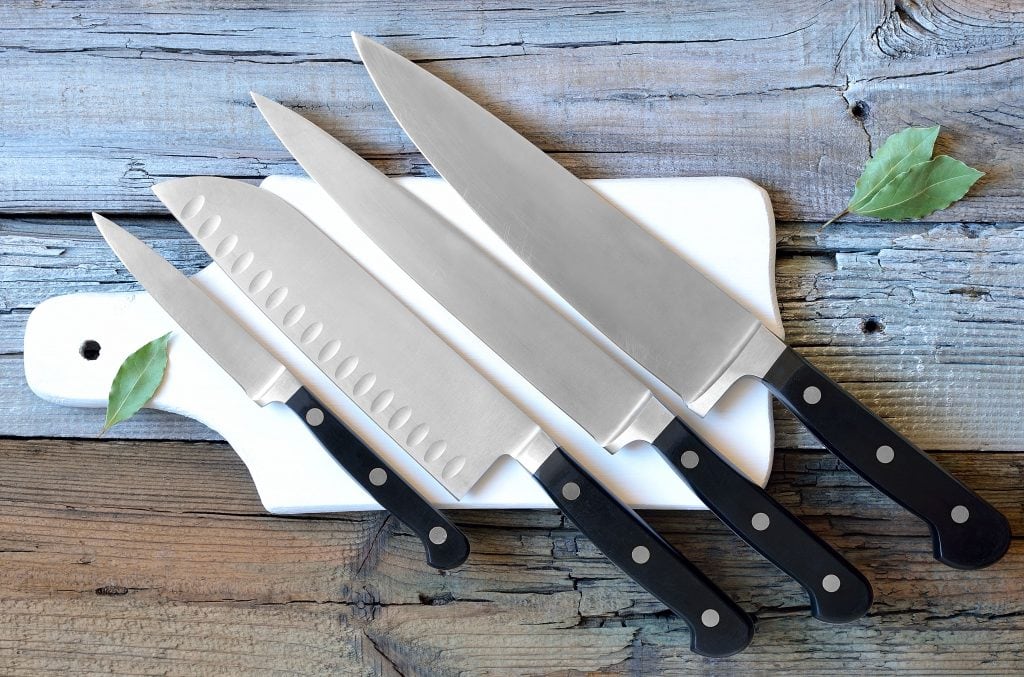
A chef knife comes into continuous contact with water, fruit and vegetable acids, fats, and other substances that may affect the blade – which itself gets constant work. However, by properly caring for your chef knife, you’ll be able to use it for years to come.
How to clean a chef’s knife?
Always clean your chef knife immediately after use. Keeping your knife clean and dry will prevent corrosion, edge dulling, and bacterial buildup.
You can clean most chef knives with dish soap, warm water, and a regular cleaning pad. Avoid detergents, corrosive materials, and solvents, which may damage both the blade and the handle.
Once you’ve rinsed off the soap, carefully dry the blade with a clean towel or paper towel, and place it to air on a knife magnet, in a knife block, etc. Do not store the knife with all the other utensils, and do not store it standing on its edge or tip.
Note that different materials, especially when it comes to the handle, clean differently and react differently to bacteria, moisture, etc. – but if you clean and dry your chef knife thoroughly, there should be no problem.
Are Chef Knives Dish-washer Safe?
Except for specific knives that are marketed as dishwasher-safe, it is generally best to clean your chef knife by hand. Dishwashers use a combination of detergents and hot water which may be detrimental to the longevity of both the knife’s blade and its handle.
Honing & sharpening your knife, How to keep your chef Knife Sharp?
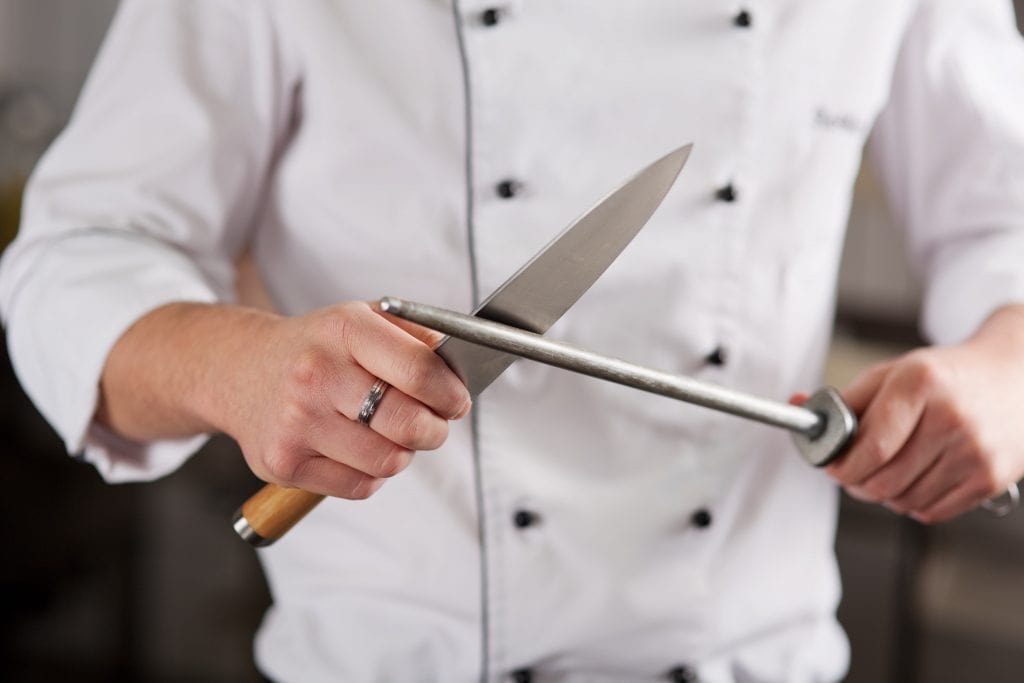
Always keep your chef knife sharp. A dull blade is more dangerous than a sharp one, as it can slip and cause injury.
If you find that your knife “struggles” to cut through common foods, stop using it immediately and sharpen it. The general guideline is to sharpen your blade every 2 to 4 uses and have it sharpened professionally once a year if possible.
In making a knife sharper, there are two techniques: sharpening is when the material is removed from the knife’s edge to create a new edge while honing is when the existing edge is straightened and centered. That steel “file” you’ve seen chefs use? That’s a honing rod.
Read now >> How to tell if a knife is sharp?
How to store a chef Knife?
For both the knife’s safety and yours, chef knives should be stored separately from other utensils. Drawers and cupboards can be humid (leading to corrosion), and the loose utensils in the drawer can nick or chip the blade. Also, you don’t want yourself or your child blindly reaching into a drawer only to meet the business end of a sharp knife.
The best solution is a wall-mounted knife magnet, a countertop knife block, or a knife block for keeping in a drawer.
What are the best Knife Blocks for sets?
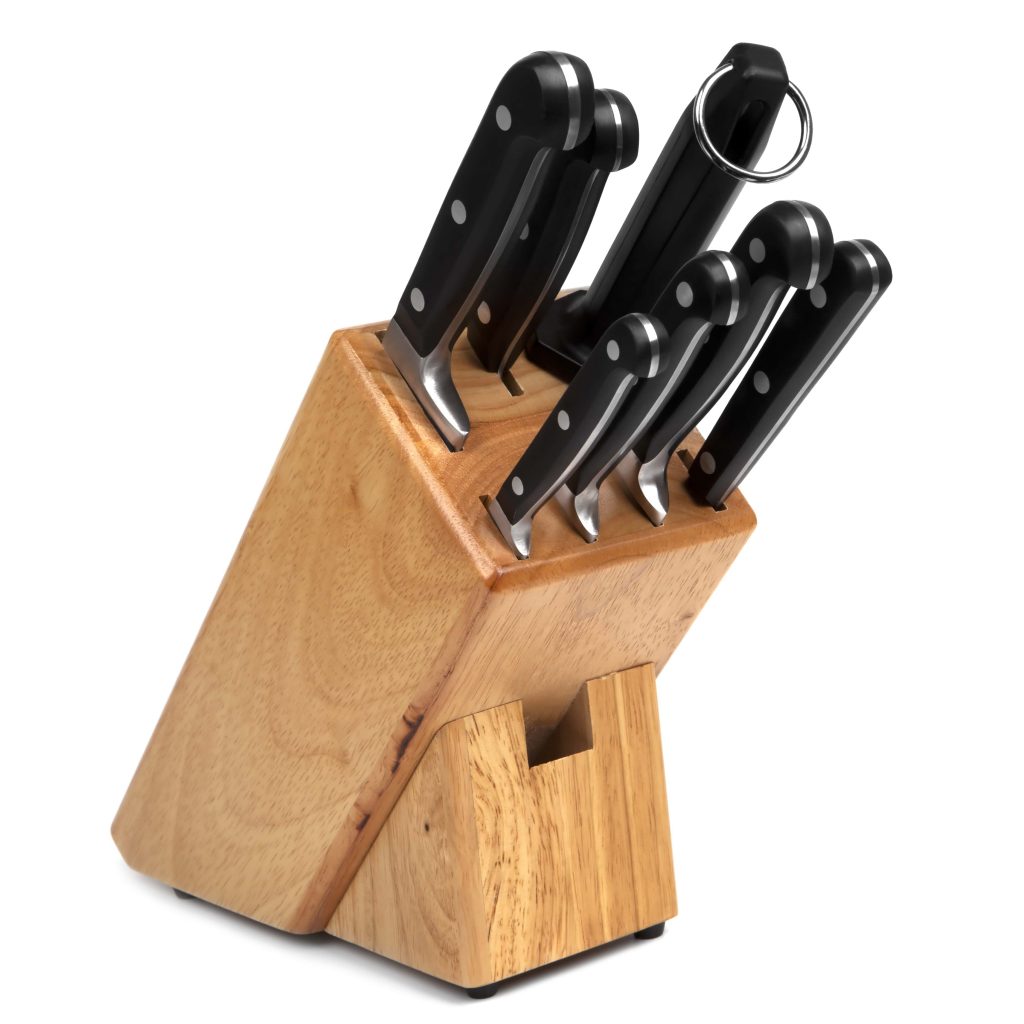
Knife blocks are used for safely storing your chef knives, paring knives, etc. on the countertop, offering you the handle part of the knife while fully containing the blade.
Knife blocks come in many designs and sizes, and normally have room for multiple knives of different sizes. Some also contain a built-in knife sharpener. You can choose a block that looks good on your counter.
One issue with knife blocks is that, unlike magnetic knife strips, they can store mold and bacteria. For this reason, make sure to thoroughly clean and dry your knives before depositing them in the block, and to periodically sanitize the block.
The best and most reliable check knife Brands
Chef knife brands vary immensely, from anonymous budget brands to names revered in kitchens worldwide. Investing in a trusted brand can provide you with a reliable knife that will serve you for years to come. Here are a few of the world’s top brands of chef knives:
Briefly name and provide product strengths(Material, typical price range, etc) for the following brands:
- MAC Knife – Hailed as “the world’s sharpest knives”, Japanese MAC knives are hand-ground and hand-sharpened by professional Japanese craftsmen using traditional methods, to achieve a characteristic “hybrid” edge that combines a chisel edge and a V-shape edge.
- Henckels International – One of the world’s oldest brands, German cutlery manufacturer Henckels has been in business for over 280 years, and their knives – using high-carbon stainless steel – are hailed by some of the biggest names in gastronomy..
- Global – The Japanese Global brand is known for its innovative all-steel chef knives, including uniquely dimpled steel handles that are specially weighted with sand. They’re sleek, well-balanced, and keep razor-sharp for long periods.
- Wusthof – One of the most valued German brands, noted for its knives’ durability and functional design. From their specially hardened and sharpened blades to their ergonomic handles, Wusthof chef knives are top-of-the-line.
- Messermeister – Literally meaning “knife master”, the Californian brand of Messermesiter forges its chef knives out of high-quality German steel, creating products known for their sharpness, precision, and versatility.
Conclusion
A chef knife is your best friend in the kitchen, and while the information in this article may be slightly overwhelming, the bottom line is this: choose a friend you’d like to spend time with. If you focus on nothing else, make sure to choose a chef knife that is reliable and that fits you.
As you use your chef knife, you’ll grow to appreciate the various aspects discussed in this article, and develop your preferences for what matters most. And if you’re like us, you’ll grow to love these versatile, masterful tools.
Good luck!
Read now >> Chinese cleaver vs Chef knife , Best Left-Handed Chef Knives
